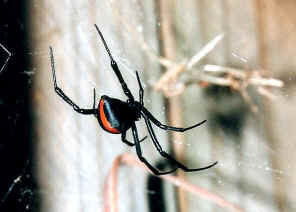|
|
Red Back Spider - Latrodectus hasseltti
Family Theridiidae
This page contains pictures and information about Red Back Spiders that we found in the Brisbane area, Queensland, Australia.
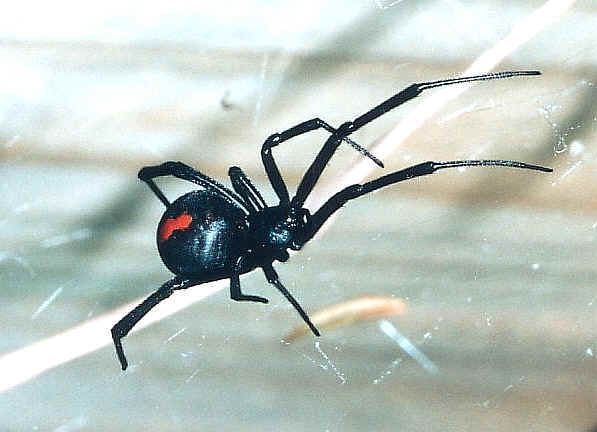
- Red Back Spider - female, leg to leg 30mm
The spider has the worst reputation is perhaps this Red Back Spider. This species and their close related species can be find through out the world and have different common name. In Australia we call them Red Back Spider or Redback while in United States the close relative are called Black Widow (Latrodectus mactans). In Europe they are known as Malmignatte. In Arabia they are called Jockey Spider, in Russia the Black Wolf. The New Zealanders call them Katipo or Night Stinger. In South Africa they are known as Swart Knopiespinnekop, or the Shoe-button.
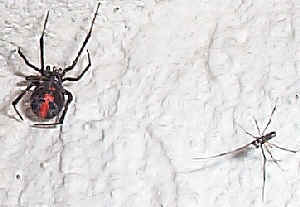

- First picture shows the female and male Redback Spiders, males are usually 1/3 of the females size. Second picture is a young female, with paler colour.
The Red Back Spiders are easily recognised. The female adults is range from 20-40mm leg to leg in size. Their body and legs are shiny black in colour with the distinctive red mark on the back. On the bottom side of the abdomen there is the red 'time-bottle' mark. The male spider is much smaller and not easily be seen unless you may find them near the females. The males are paler in colour. The young female Red Back spiders have the red marks in orange colour and with a white edge around it.
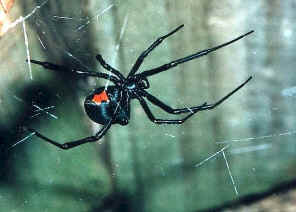
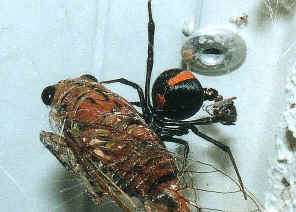
- On the bottom side of the abdomen of Red Back Spider, there is the red 'time-bottle' mark. The second pictures show the Red Back having a large meal, a Brown Bunyip Cicada.
Red Back Spiders feed on all kinds of small insects and on other species of spiders. When something is caught in its web the spider runs down and wraps it up in broad band of silk which is pulled out of its spinnerets by the combs on the spider's hind legs. After the prey is tied up the spider will bite it and carry it back to the nest. The spider will suck up the juices of the prey and leave the ex-skeleton outside the web.
Before the invention of the anti-venom, Red Back Spiders have been responsible for a number of deaths over the years. The anti-venom was invented in 1956. Since then only one death has been recorded although hundreds of people are bitten each year in Australia. However, there are still some deaths reported in other countries.
It is only the females which can kill humans, the males are too small and their fangs are not strong enough to penetrate human skin. The Red Back Spider is considered the most dangerous is because they live within human habitation. They are found in the outside- toilet where you may sit on. They live under the garden rubbish, when you clear the rubbish with bare hands, you will most likely put your arm in front of their fangs. If you leave your kid's bicycle in your backyard for a few day you may find a Red Back Spider living comfortably in a nest build on the bicycle peddles.
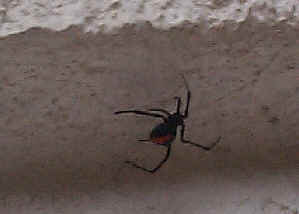
- Red Back Spider hides in its nest on day time, usually under cover and out of your sight.
The Red Back Spiders may not be easily seen although they may live very close to you. They hide in their nest during the day, usually under cover and out of your sight. They will hanging up-side-down just in front of their nest after evening. They build massy tangle webs. The silk lines are strong and shiny silver when compared with other species of spiders. Their nest are sometimes covered by dry leaves and insects remains. With some experience their webs are easily be identified.
When you see a Red Back Spider, don't be panic, for they are not aggressive. If disturbed they prefer to run away rather than stand and fight. They will attack human only if their egg sacs are disturbed or there is no way to escape. Because they are dangerous so they should be distorted as soon as possible. Before you distort the Red Back Spider, try to recognise their web first so that you can spot them by just looking at their webs. This is also a good idea to ask your family members to recognise the Red Back Spiders and their webs so that they can avoid them.
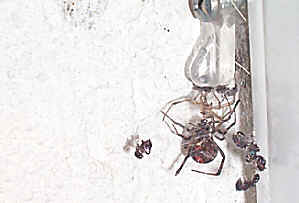
- A typical Red Back Spider nest near the outside windows frame, a massy tangle web with strong silk line. Notice usually there are the insects remains just outside the retreat. In day time, the spider hides under the knob.
Insecticide may not be the best way to get rid of Red Back Spiders. Some insecticides are not effective to Red Back Spiders. Another reason is when using insecticide, all other species of spiders are cleaned away and when the insecticide effect become weaker, usually the Red Back Spiders are the first spiders come back to occupy the vacancy. If you choose to control Red Back Spiders by chemical sprays by yourself or by pest control company, spraying must be repeated frequently.
The most effective way to control Red Back Spider is to find them out and distort, and then discourage their existing by their natural enemies. To hunt for the Red Back Spider, don't forget a pair of gloves and shoes. I will use a stick, over 30cm(1 foot) long, as my weapon. Try to hit quickly and precisely for the Red Back Spider will react very quickly. Before the stick hit the spider, it will touch the outer silk lines first so the spider may have enough time to escape. Using a shoe or a sandal as weapon is not good for they are big and will disturb the silk easily. Moreover they will block you eye sight so that you cannot see where the Red Back Spider has gone. From my experience, it is not always easy to hit the spider at first attack. If the spider escape it will either run back to its nest or drop down on to the ground. In either case they may not be found again but don't worry, wait for the next day at the same location. You will see it again. While your attack, if you miss the Red Back Spider and find it disappears, make sure it is not on your clothes.

- Red Back Spider egg sac
If the Red Back Spider is killed, make sure to check if there are any egg sac, which is a white yellow creamy silk ball 5-10mm in diameter. If found, it should be distorted as well.
The natural enemies of Red Back Spiders are some other species of spiders. They include the Black House Spiders and Daddy Long-Legs which are known to hunt and feed on Red Back Spider. The Comb-footed Spiders have the similar habit of Red Back Spiders and will occupy their habitats. Those spiders are quite harmless to human (Black House Spiders will bite but not fatal) and they are essentially the best method to control the Red Back Spiders.
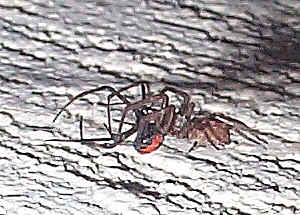
- Red Back Spider's natural enemies, the picture shows the Black House Spider feeding on Red Back Spider.


- Red Back Spider's natural enemies, the pictures show Daddy Long Legs spiders going to attack the Red Back Spider.
- Red Back Spider's natural enemies, the picture shows the Black House Spider feeding on Red Back Spider.
If anyone is bitten they should go immediately to a doctor or hospital. If possible, kill and bring along with the spider for identification, for if will help to choose the correct anti-venom. The bite effects are highly variable, from mild to severe, even death without antivenom. At first the bite is only as painful as a insect sting. After a few minutes the pain becomes intense and spreads to other body parts. The bitten limb will usually sweat while the other part of the body remain dry. Other common symptoms include muscular weakness, paralysis, stiffness, tremors and loss of coordination. Some victims may develop serious symptoms after three hours, they include nausea, vomiting, dizziness, irregular heartbeat and fever. The serious venom effects will take hours to develop and there should be plenty of time to seek for medication.
A message from the book "Venomous Creatures of Australia 1981 by Dr. Struan K. Sutherland of the Commonwealth Serum Laboratories" is copied here for reference: First Aid to Red Back Spider bite - The venom of this spider moves very slowly and any attempt to slow it down further increases pain so no restrictive bandages should be used. No first aid is required. Seek medical aid at once. Take along the spider in a jar for positive identification. Iced water made by mixing ice and water in a plastic bag if applied to the bitten area may reduce the pain - but do not freeze the skin. Please notice that this message applies to Red Back Spider bite only. Bites and stings by other spiders, insects, snakes or other creatures will have different methods.
Actually most Red Back Spider bites can be avoided. Learn and teach your family members to recognised the Red Back Spiders and their web and avoid them. Most importantly, make sure you have protection, such as a pair of gloves, before you start the gardening works.
Questions for Discussion
Kris from United States has the different opinions on how I suggested to handle the Red Back Spiders. Kris' idea is extracted as follow, then is my reply.
Kris: I was disturbed about the site to Red Back spiders, also known
as Black Widows. Why do you feel it is necessary to destroy these spiders, and,
more importantly, their egg sacs? Forgive me if I sound ignorant, but I have had
many encounters with Black Widows, and I enjoy raising them as pets. You
mentioned that these spiders are timid, and don't usually bite, so why do you
kill them? You need not worry about them unless you're allergic to bees, in
which case you could potentially become one of the 6 in 400 cases of Black
Widows bites that is fatal. I really think further examination of these spiders
shows without a doubt how useful they are in destroying pests. Perhaps, if I may
suggest, trap them in a mason jar and relocate them instead of killing them.
Reply: I still think that my suggestion is the best for both spiders
and us. I convince people to remove the Red Back Spiders by killing them
individually. I believe this is an effective method. Otherwise most people
will use insecticides or call the pest control company, all different spiders
and insects will be killed. Red Back Spiders are really pest in here. Without
taking any action, we easily find 20 or more in our 200sq. meter backyard.
Although low possibility of fatal bit, there is the risk. Most visitors just
want to know what the spider look like and what will happen if get bitten.
They may not know much about spiders. Remove spider by a jar could be too
risky. We should keep spiders in wild as they should be. Killing them
individually will not harm to their population in wild.
